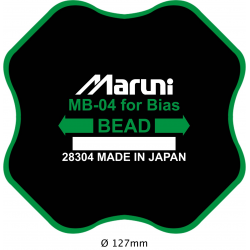Ilość
- New Products
- Tire repairs materialsexpand_moreexpand_less
- Weights for wheel balancingexpand_moreexpand_less
- Valvesexpand_moreexpand_less
- Consumablesexpand_moreexpand_less
- Toolsexpand_moreexpand_less
- TPMSexpand_moreexpand_less
- Car air conditioningexpand_moreexpand_less
- Compressors and pneumaticsexpand_moreexpand_less
- Workshop equipmentexpand_moreexpand_less
- Accessories for Workshop Equipment
- Outlet
- Recommended
- Brandsexpand_moreexpand_less
BIAS PATCH MARUNI MB-04 127mm
Quantity
BIAS PATCH MARUNI MB-04 127mm
MB/MS Patches for Repairing Diagonal Tires
MB/MS patches are used for repairing diagonal (bias-ply) tires, ranging from passenger vehicles to construction machinery.
They are made of a reinforced rubber compound and ultra-durable internal nylon fibers.
The outer surface is coated with a protective layer that safeguards against high temperatures.
They are easy to apply, and the vulcanizing adhesion reaction occurs quickly and reliably.
MB/MS patches can be used for hot repairs.
For best results, use with Super Valkarn vulcanizing cement and SEALINER.
-
MS patches should be used for sidewall repairs.
-
MB patches should be used for all other areas of the tire.
How to Repair a Diagonal Tire Using the Cold Repair Method
Required materials:
-
Super Valkarn vulcanizing cement
-
MB patch for diagonal tires
-
STEM repair plug
-
Buffer spray for roughening
-
Sealiner
Step-by-step instructions:
-
Use pliers to remove any foreign objects from the puncture and mark the damage area with chalk.
-
Drill the damaged area multiple times from both the outside and inside of the tire using a carbide cutter.
-
Thread the plug through a plug-puller (unnecessary for new-type plugs with guide wire).
-
Remove the protective film from the STEM plug and coat it with Super Valkarn vulcanizing cement.
-
Apply a small amount of Super Valkarn vulcanizing cement into the puncture channel.
-
If using a plug without a guide wire, insert it using the plug-puller.
-
Pull the plug through the tire using pliers from the outside. A section of the plug should protrude on the inner side.
-
Cut the inner end of the plug so that it sticks out 2–3 mm from the tire surface.
-
Position the patch on the inner tire wall and mark an area slightly larger than the patch using chalk. Make <span class="NormalTextRun SpellingErrorV2Themed SCXW209101723 BCX8" style="margin:0px;padding:0px;background-position:0px 100%;background-repeat:repeat





